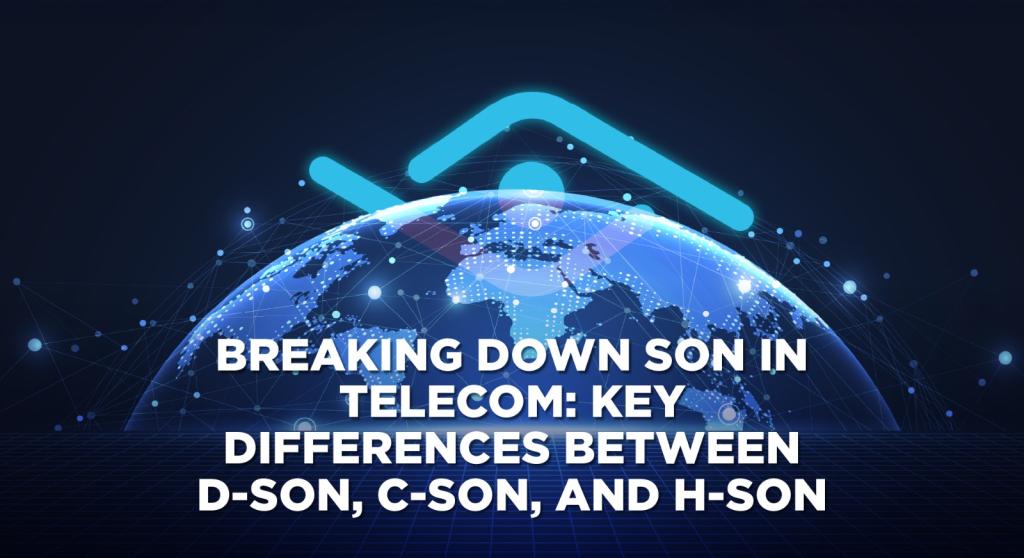Mobile networks’ increasing complexity and data demands have made intelligent and autonomous operations essential. Self-optimizing networks (SON) offer a solution by automating key network functions for telecom operators, leading to improved performance and reduced operational costs.
In this blog, we dive into the three types of SON: D-SON (Distributed SON), C-SON (Centralized SON), and H-SON (Hybrid SON) — explaining how each one works, their unique benefits, and where they best fit in a modern network environment.
What Are Self-Optimizing Networks (SON)?
Self-optimizing networks are a key component of automation in telecom. SON solutions use real-time data and algorithms to automate configuration, optimization, and fault management across the Radio Access Network (RAN). These capabilities make SON a crucial enabler for 4G and 5G deployments.
Telecom operators often turn to a self-organizing network vendor to deploy SON software that can scale with evolving demands and technologies. Depending on network structure and automation needs, operators may choose between different SON architectures: D-SON, C-SON, or H-SON.
D-SON (Distributed SON)
The intelligence is embedded directly within the base stations or network elements in D-SON. It operates locally, processing data at the network edge and reacting in near real-time.
Key Benefits of D-SON:
- Low latency and faster decision-making
- Localized optimization without dependency on a central controller
- Ideal for real-time functions like load balancing, interference mitigation, or coverage adjustment
Limitations:
- Lacks a global view of the network
- It can result in conflicting actions between nodes if not adequately coordinate.
C-SON (Centralized SON)
C-SON centralizes the intelligence in an external server, usually in the network’s Operations Support System (OSS). It analyzes the entire network’s performance and orchestrates actions across multiple cells and vendors.
Key Benefits of C-SON:
- Offers a network-wide perspective
- Ideal for tasks requiring coordination across multiple elements, such as Automatic Neighbor Relations (ANR) and KPI-based performance tuning
Easier integration with network analytics and vendor-agnostic environments.
Limitations:
- Higher latency due to centralized processing
- Requires robust backhaul capacity for real-time responsiveness.
H-SON (Hybrid SON)
H-SON combines the best of both worlds — blending D-SON’s speed with C-SON’s coordination capabilities. This hybrid approach is increasingly seen as the most effective way to implement self-optimizing networks in today’s multi-layered, multi-vendor environments.
Key Benefits of H-SON:
- Allows local, real-time optimization at the RAN level.
- Coordinates decisions across the entire network to avoid conflicts.
- Ideally suited for 5G architectures and advanced use cases like energy-saving, real-time anomaly detection, and automated configuration.

C-SON (Centralized SON)
C-SON centralizes the intelligence in an external server, usually in the network’s Operations Support System (OSS). It analyzes the entire network’s performance and orchestrates actions across multiple cells and vendors.Key Benefits of C-SON:
- Offers a network-wide perspective
- Ideal for tasks requiring coordination across multiple elements, such as Automatic Neighbor Relations (ANR) and KPI-based performance tuning Easier integration with network analytics and vendor-agnostic environments.

Limitations:
- Higher latency due to centralized processing
- Requires robust backhaul capacity for real-time responsiveness.
H-SON (Hybrid SON)
H-SON combines the best of both worlds — blending D-SON’s speed with C-SON’s coordination capabilities. This hybrid approach is increasingly seen as the most effective way to implement self-optimizing networks in today’s multi-layered, multi-vendor environments.
Key Benefits of H-SON:
- Allows local, real-time optimization at the RAN level.
- Coordinates decisions across the entire network to avoid conflicts.
- Ideally suited for 5G architectures and advanced use cases like energy-saving, real-time anomaly detection, and automated configuration.
D-SON vs. C-SON vs. H-SON: A Quick Comparison
| Feature | D-SON | C-SON | H-SON |
| Intelligence Location | Base station (edge) | Centralized (OSS/NMS) | Both edge and centralized |
| Response Speed | Fast | Moderate | Fast + Coordinated |
| Network View | Local | Network-wide | Local + Global |
| Best Use Case | Load balancing | KPI-based optimization | Real-time + coordinated SON |
| Scalability | Medium | High | Very High |

How to Choose the Right SON Architecture for Your Network
Selecting the right SON (Self-Organizing Network) architecture is a strategic decision that directly impacts your network’s agility, scalability, and long-term operational efficiency. A thorough assessment of your current infrastructure, performance goals, and future roadmap should guide the choice between D-SON, C-SON, or H-SON.
Here are the key factors to consider:
1. Network Complexity
- Single vs. Multi-Vendor Environments: A centralized or hybrid approach is generally more effective if your network includes equipment from multiple vendors due to its holistic oversight and vendor-agnostic capabilities.
- Multi-RAT (Radio Access Technologies): Supporting a mix of 2G, 3G, 4G, and 5G technologies requires a SON solution that can coordinate across layers and standards. In such scenarios, H-SON maintains local responsiveness and network-wide optimization.
2. Latency Requirements
- Real-Time Optimization: If your operations demand rapid reaction times — such as load balancing, handover optimization, or interference mitigation — D-SON is well-suited due to its low-latency nature.
- Coordinated Adjustments: If synchronization across multiple cells or regions is more critical, C-SON or H-SON becomes the better option, ensuring consistent policies and conflict-free actions.
3. Automation Goals
Determine what level of automation your team is aiming for:- Basic automation (e.g., ANR or KPI-based tuning) may be achievable with D-SON or C-SON.
- Advanced self-optimization—like predictive fault avoidance, intent-based configuration, and closed-loop assurance—requires the depth and adaptability that H-SON offers.
4. Investment in Cloud-Native and AI-Based Operations
- As more networks move toward cloud-native architectures and AI-powered orchestration, choosing a SON model that integrates with these ecosystems is crucial.
- H-SON, in particular, can leverage edge computing for real-time decisions (D-SON) while utilizing centralized AI models (C-SON) for learning, prediction, and network-wide policies.
5. Operational Scalability and Long-Term Vision
- Your SON architecture should evolve alongside your network.
- H-SON provides a future-proof framework that supports gradual migration from legacy systems to full-scale 5G and beyond.
- It enables telecom operators to start with distributed capabilities and layer on central intelligence as the complex network grows.
Partnering with the Right Self-Organizing Network Vendor
Deploying and maintaining a robust SON solution requires deep expertise. A trusted self-organizing network vendor like Innovile helps telecom operators:- Design flexible SON architectures (D-SON, C-SON, H-SON).
- Ensure compatibility across multi-vendor environments.
- Enable future-ready automation strategies for 5G.
Conclusion
Self-optimizing networks are no longer optional — they’re essential. Whether D-SON, C-SON or the increasingly popular H-SON, choosing the right SON model can unlock tremendous operational efficiency and network performance gains. Are you ready to take your network to the next level of automation?.
Partnering with the Right Self-Organizing Network Vendor
Deploying and maintaining a robust SON solution requires deep expertise. A trusted self-organizing network vendor like Innovile helps telecom operators:
- Design flexible SON architectures (D-SON, C-SON, H-SON).
- Ensure compatibility across multi-vendor environments.
- Enable future-ready automation strategies for 5G.
With Innovile’s INNTELLIGENT Self-Organizing Network Management System, operators benefit from modular capabilities that adapt to evolving network demands while delivering measurable ROI through automation.
Conclusion
Self-optimizing networks are no longer optional — they’re essential. Whether D-SON, C-SON or the increasingly popular H-SON, choosing the right SON model can unlock tremendous operational efficiency and network performance gains.
Are you ready to take your network to the next level of automation?
